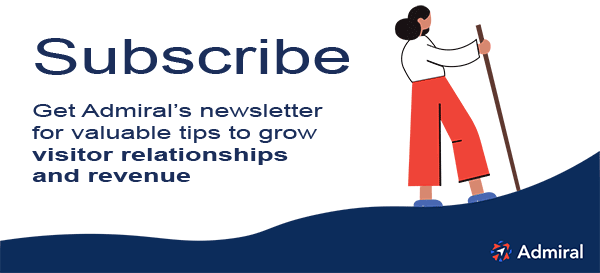As we enter a post third-party cookie world, some media publishers are evaluating their relationship with the major platforms, and the pros/cons of a walled garden advertising strategy. Walled gardens in advertising can deliver enormous benefits and can present significant obstacles.
Can news and media publishers learn from the strategy, and find ways to enjoy some of the benefits of a walled garden, while building a hedge against competitors, platform dominance, and growing privacy regulations?
FAQs: Digital Walled Gardens
- What is a walled garden?
- What are some examples of a walled garden?
- What are the benefits of a walled garden?
- What are the challenges to building a walled garden?
- How can Admiral help publishers grow their own walled garden?
What is a walled garden?
In the context of the Internet and advertising, a walled garden is a closed digital ecosystem. It's designed so that all activities stay within this defined space. All data and technology work together seamlessly and strengthen each other. In the case of Apple, their hardware, operating systems, apps, devices, and services all work well together, and drive long term user loyalty.
You might see the term advertising walled garden referring to a platform where one publisher owns the ad buy, delivery, visitor tracking, and reporting while collecting its data (first-party data strategy) to enhance all parts of its own ecosystem.
What are some examples of an advertising walled garden?
Google's ad ecosystem is a great example of a walled garden. As publishers, we're well aware that Google manages both sides of the ad experience.
They sell ad space through Google Ads and they pay publishers for their ad inventory through Google AdSense. Google collects first-party data on both sides of this transaction to enhance the advertiser's, visitor's, and publisher's experience.
It shares that data with advertisers in a controlled way. And ultimately, this increases Google's ad revenues.
At the same time, the existence of this walled garden approach also drives down competition because so much of the ecosystem has been dependent on Google Ads.
Because Google owns the "garden", advertisers and publishers have less control over the process and data. They have to trust that Google is providing them with accurate data.
Facebook, Apple, and Amazon are other walled garden advertising examples that control much of the experience of their users, with strong access control on how third parties can engage.
When publishers rely on the walled garden ad ecosystems of Facebook or Google, have largely outsourced the visitor relationship, heavily relying on the platform's tag and targeting. They gain some scale and insights but don't own the visitor relationship or the data.
What are the benefits of a walled garden?
Walled gardens balance protection with access - Like a real walled garden protects plants from encroaching weeds and gives the gardener more control over the garden space, a walled garden in advertising creates a closed ecosystem where a parent company can securely control the environment.
Walled gardens collect accurate and in-depth personal data - Walled gardens have a wealth of visitor data to gain deep insights that can be used for very granular ad targeting and personalization. Digital walled gardens can wield a degree of power by selling or offering to share some of their segmentation data while setting favorable terms.
A hedge against platform dominance - Media publishers like the NYTimes or Business Insider can build larger internal data sets, and tools for collecting more first-party and zero-party data, to be less impacted by large platform changes from Google or Facebook.
These large companies build "windows" into their digital walls that give partners access to certain insights while protecting those from whom you collect data. Additionally, the digital walled gardens typically have a more seamless experience across many different devices a visitor may use to access them.
Walled gardens deliver visitor benefits to drive greater loyalty and revenue - Visitors want something a walled garden offers. A digital walled garden is a consent-based space, and may have a more consistent UX, greater privacy controls, network effects between members, and more relevant content. Digital walled gardens can engage the visitor more often, build a relationship, gain more volunteered data, and turn that into better experiences.
People signing up for Facebook, Apple, Google or Amazon are opting into those closed eco-systems, and rely on them for ongoing quality content and experience. With great power comes great responsibility; ideally, an advertising walled garden cares about the community it builds, protects its privacy, and continues to deliver value in exchange for loyalty.
As long as the digital walled garden enhances the user experience rather than restricting it, this offers a publisher some protection from current and future privacy regulations and other consumer laws focused on third-party access to personal data.
What are the challenges to building a walled garden?
Advertising walled gardens are resource-heavy - It can take a lot to build a walled garden from scratch and maintain it. A publisher may need to invest in a full martech stack, developers, support, an ad stack they can own and customize, more sophisticated tools for managing and segmenting data, and the expertise to manage it all.
The product/content must be top shelf- To gain the loyalty necessary for the ROI of a walled garden, the product must be highly valued. For Apple, they invest heavily in user experience and design. For a publisher, the content, experience, and research need to be top-notch for a sustainable walled garden system.
Publishers need to drive visitor engagement - Traditionally, many publishers have taken a passive approach to visitors, focusing on creating content to attract visitors, and serving ads to pay the bills. This approach is under attack by adblockers, as well as privacy regulations, and competition from 1000's of content options open to consumers.
To collect the level of sophisticated visitor data a publisher would need to derive some walled garden benefits of their own, they need to do more than publish content. They need to engage visitors, facilitate interactions, and have access control. Surveys, games, quizzes, online communities, forums, comments, calculators, newsletters, social follower growth, and more, will drive much more data for a publisher to turn into better targeting and visitor experience.
How can Admiral help publishers grow their own walled garden?
Admiral's Visitor Relationship Management (VRM) platform can help publishers take steps to gain the benefits of a digital walled garden while avoiding the challenges.
VRM can help future-proof ahead of a post-cookie world where publishers can better control their own destiny. Admiral provides the toolset and automation for pubs to manage template or custom value exchanges with their visitors, at scale. Offer each visitor the right offer at the right time to increase engagement, first-party data, and ultimately revenue.
Admiral has built a marketing automation tool with a visitor engagement layer, an AI-driven journey builder, and sophisticated targeting and automation settings. With a dev-light one-tag install, pubs can offer paid subscriptions, recover adblock revenue, collect visitor consent for GDPR, visitor authentication, and more across the visitor journey.
VRM takes media publishing to the next level, up from passively hoping the content delivers, to actively building brand affinity and lifetime value. All while collecting greater data to inform the next offer, the next experience, and improving their direct ad sales options.
To find out more, schedule a demo of Admiral's VRM platform:






